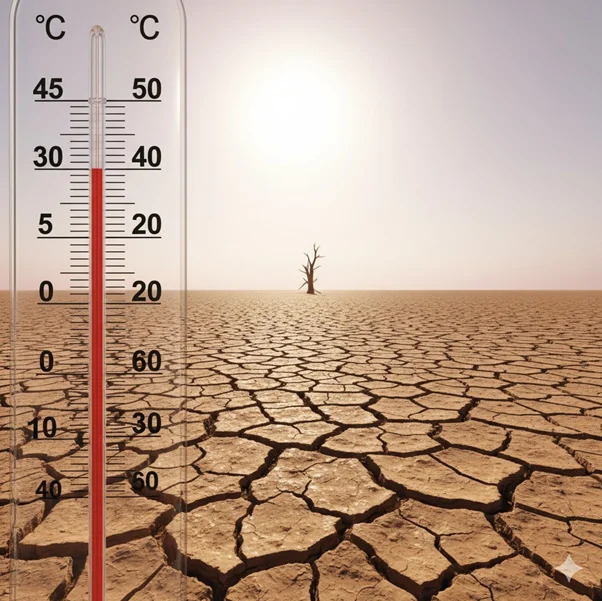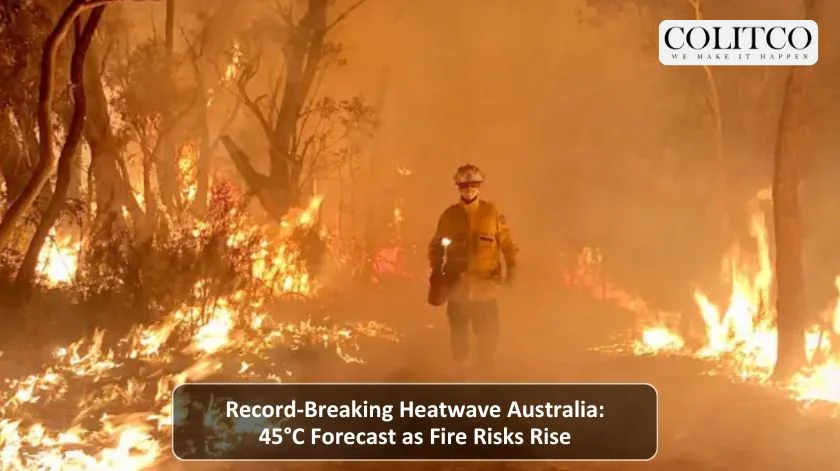Unseasonal Temperatures Threaten to Shatter October Records
Australia is preparing to experience a severe heat wave this weekend, with temperatures expected to rise to over 45 °C in some areas, setting the stage for a record heatwave in the country. The Bureau of Meteorology (BOM) and Weatherzone have issued warnings that an unusually hot mass of air, traveling eastward through Western Australia, will cause the highest readings in October in more than 20 years.
Extreme Heat Grips Southern and Central Australia
The states of South Australia, Victoria, and New South Wales are likely to be the worst hit by the record-breaking heatwave. On Sunday, it may reach 31 °C in Adelaide, and high temperatures in some areas of the North of South Australia are expected to be over 43 °C. Scorching conditions have already been experienced in Western Australia, with Marble Bar, the hottest part of the state, reaching 44.8 °C this week.

Extreme temperatures across inland Australia could break long-standing October records.
It is predicted that Sydney will reach 33 °C early next week, after which the remarkable change will pass through the area. Canberra and Melbourne will also be prone to unseasonably warm temperatures, peaking at about 31 °C, before the heat subsides.
Meteorologists Warn of Bushfire Danger
The Bureau of Meteorology has also issued several fire weather warnings, and dry air and strong winds are coming together to form dangerous conditions. Even minor sources of ignition have been warned against by fire authorities, as they could cause a rapidly spreading fire.

Authorities warn that hot, dry, and windy conditions will heighten bushfire risks this weekend.
The BOM remarked that the length and intensity of the heatwave were scarce in the middle of October, the time when the mildness of the spring weather is expected. The agency attributed the heat trapping to the high-pressure system moving slowly over the country’s interior, which was trapping hot air and exacerbating the heat.
Australia’s Hottest October Days on Record
The current heatwave in Australia may reach temperatures near the record high of 46.9 °C set in Port Hedland in 2002. Meteorologists indicate that these rising temperatures reflect global climate change, resulting in more frequent and prolonged heatwaves.
According to Weatherzone, some inland towns, such as Birdsville and Tarcoola, can reach temperatures above 45 °C over the weekend. The Top End is already experiencing near-record heat, triggering health and fire warnings.
Health Authorities Urge Caution
Health agencies in the country are advising people to drink water, avoid rigorous outdoor physical activities, and check on weak neighbors. Excessive heat may cause dehydration, heat exhaustion, and in extreme situations, heat stroke.

Health officials urge residents to stay hydrated and limit outdoor activity during peak heat.
Authorities suggest that it is necessary to ensure homes are cooled by drawing blinds, using fans or air conditioning, and avoiding direct sunlight during the hottest times of the day (afternoons). Animals are also being encouraged to provide shade and water to other animals as the temperatures increase.
Cooling Change Expected but Risks Remain
A break from the record-breaking heatwave is anticipated early next week as a cold front moves through parts of southern Australia. However, forecasters warn that another warm spell may follow later in the month, highlighting the fluctuating weather patterns typical of this spring season.
Experts also note that the early onset of heat from such events may increase the risk of a severe bushfire season, particularly given the dry vegetation and low rainfall prospects as summer approaches.
Also Read: llers Face Rising Threat from Global Chikungunya Outbreak
Final Thoughts
Australia is experiencing a record-breaking heatwave in October, highlighting that the country’s climate has become increasingly volatile. With an increasing number of temperature extremes, governments and communities are being called upon to better prepare for heat-related emergencies.
As forecasters predict this could be one of the hottest Octobers in years, Australians are being cautioned to be wary, pay attention to official weather reports, and take steps to reduce heat exposure and the risk of fires.
FAQs
1. What causes a record breaking heatwave in Australia?
A record breaking heatwave in Australia is usually caused by a combination of meteorological and climatic factors.
A strong high-pressure system can become stationary or slow-moving, leading to clear skies, light winds, and strong solar heating. Warm air from inland regions moves toward the south and coast, while dry soil reduces evaporation, trapping more heat.
Climate change has also raised baseline temperatures, making extreme heat events more frequent and more severe.
2. Which parts of Australia are most affected by heatwaves?
Heatwaves affect many regions across Australia, but inland and southern areas are often hardest hit.
The interior and outback experience high base temperatures and low humidity, while southern states such as South Australia, Victoria, and New South Wales often see extreme spring and summer heat.
Northern Australia, including the Top End, faces frequent hot spells, often with high humidity. Coastal areas can also experience intense heat, especially when inland winds replace cooling sea breezes.
3. When was Australia’s hottest recorded temperature?
Australia’s highest recorded air temperature is 46.9°C, registered in Port Hedland in October 2002.
The national average temperature record was also broken in December 2019, when the mean temperature across the country reached 40.9°C.
4. How long do heatwaves usually last in Australia?
In Australia, a heatwave generally lasts for at least three consecutive days of unusually high maximum and minimum temperatures.
Some prolonged heatwaves can continue for up to 10 days or more, particularly when reinforced by stable high-pressure systems or repeated bursts of hot inland air.
5. What are the health risks of extreme heat in Australia?
Extreme heat can cause dehydration, heat exhaustion, and heatstroke. It can also worsen heart, lung, and kidney conditions.
Vulnerable people, including the elderly, young children, and those with chronic illnesses, are at higher risk.
Prolonged heat can also disrupt sleep, lower productivity, and create dangerous conditions for outdoor workers and pets.
6. Is this heatwave linked to climate change?
Yes. Long-term warming trends caused by greenhouse gas emissions are making heatwaves in Australia more frequent, intense, and longer-lasting.
Climate change has raised the country’s average temperatures, increasing the likelihood of record-breaking heat events.
While each individual heatwave is driven by weather patterns, global warming makes these extremes more probable and more severe.
7. How can people protect themselves during severe heat?
To stay safe during a heatwave:
- Drink plenty of water to stay hydrated.
- Avoid strenuous outdoor activities during peak heat hours.
- Keep to cool or air-conditioned spaces where possible.
- Wear light, loose-fitting clothing and use sunscreen.
- Check on elderly neighbours, children, and pets.
- Keep blinds or curtains closed to block out heat.
- Never leave anyone or pets in parked cars.
8. Does Australia have a heatwave warning system?
Yes. The Bureau of Meteorology operates a national heatwave warning system.
Warnings are issued when temperature thresholds and duration reach dangerous levels.
These alerts help communities, health services, and emergency authorities prepare and respond effectively to extreme heat events.
9. Will this heatwave increase the bushfire risk?
Yes. Extreme heat combined with dry air, wind, and low humidity significantly increases the risk of bushfires.
Dry vegetation ignites more easily under such conditions, and strong winds can rapidly spread flames.
Authorities have issued fire weather warnings across multiple states to reduce the likelihood of fire outbreaks during the ongoing heatwave.












